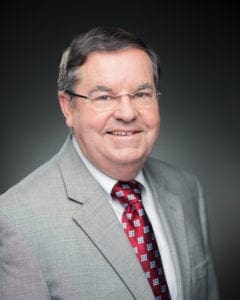 Myron Laible is Vice President, State, Local and Regulatory Affairs for OAAA. He has been with OAAA for 30 years. He is also an officer for the Foundation for Outdoor Advertising Research and Education. Laible was elected to the OAAA Hall of Fame in 2007, an honor given every two years to individuals demonstrating longtime meritorious service to the industry. Before joining OAAA, Laible was employed by the Federal Highway Administration (FHWA), where he ran the daily operations of the Highway Beautification program, including oversight of the outdoor advertising control program at the national and state levels.
Myron Laible is Vice President, State, Local and Regulatory Affairs for OAAA. He has been with OAAA for 30 years. He is also an officer for the Foundation for Outdoor Advertising Research and Education. Laible was elected to the OAAA Hall of Fame in 2007, an honor given every two years to individuals demonstrating longtime meritorious service to the industry. Before joining OAAA, Laible was employed by the Federal Highway Administration (FHWA), where he ran the daily operations of the Highway Beautification program, including oversight of the outdoor advertising control program at the national and state levels.
Myron, how did you happen to join OAAA?
I was a member of FHWA’s highway beautification staff in Washington, DC during a time when the government, the OOH industry, and anti-billboard interests actively battled over the future of outdoor advertising controls. I helped spearhead a Presidential Commission during the early 1980’s. FHWA had announced forming the commission at a 1978 OAAA Legal/Legislative convention much to the consternation of its members. The commission ultimately deadlocked on billboard enforcement issues, and soon the “Lady Bird Johnson” era was over. OAAA’s Vern Clark seized the opportunity to invest in outreach programs to state associations and government organizations. So, I had a good precedent to leave the regulatory side at FHWA and join the industry side with OAAA.
How do you assist OAAA members with State and Local regulatory matters?
I work to preserve, protect, and enhance the industry’s OOH media assets. This is done, in part, by building and maintaining an extensive on-line regulatory and legislative “tool kit” for members. To keep pace with current issues facing our industry, relevant data and facts are researched and published.
One thing to keep in mind is that our media is one of the few industries in the United States impacted by all three levels of government. So, being prepared for threats or any change is paramount to our mission at OAAA.
What’s a typical day like for you?
There is never a “typical day.” I do all I can to assist and inform members about a variety of regulatory issues, such as OSHA and operations concerns, digital billboards implementation, and ongoing state and local enforcement matters.
There is never a dull moment. It amazes me how “new” issues continue to evolve, even with 1970’s era federal regulations.
Issues we track and support vary, from just compensation and billboard valuation to scenic byways and vegetation controls. Recently, there is more industry emphasis on billboard relocation in lieu of “takings.” Preserving valuable media assets along with installing digital billboards works in concert with improving overall media technology.
The best part of my job is working directly with our members to achieve “reasonable and prudent” laws or regulations. Many key wins have resulted after years of effort – all due to the fact that our members never quit. Perseverance is a must.
What concerns do state and local governments raise over digital signs and how can those concerns be mitigated?
Practically all states now allow digital billboards along federal and state controlled highways. This has been a top priority of OAAA’s for over a decade. More than 1,000 localities allow digital billboards, and the latest OAAA inventory report lists over 6,400 units nationwide.
More recent digital billboard concerns focus primarily on lighting measurement and brightness. OAAA research helped structure criteria (i.e., a 0.3 footcandles over ambient light standard) to assist regulators and to ensure digital billboard brightness is not a community concern.
Did the Obama Administration increase Highway Beautification Funding and could this mean a buyout of more non-conforming signs along interstate freeways?
Several points about funding and sign removal issues:
- The recent long-term highway bill, enacted in December 2015, did not specifically increase funding for sign removals. However, funds to widen or improve existing highways was approved; this could result in existing billboards being affected. A top priority for OAAA is to encourage relocation of a billboard “asset” affected by a highway widening and not the acquisition or removal.
- Presently, federal statutes allow a voluntary funding program to enhance the roadside environment, such as rails to trails, scenic byways, landscaping, and other activities. Federal funds can be used if requested by a state for control, inventory, and removal of outdoor advertising. At this time, outdoor advertising is listed as the lowest priority for states to use these funds. It appears that this trend will continue.
What are the best restaurants in Washington DC for an out-of-towner to visit?
When you visit OAAA, there are two exceptional restaurants right near our office. iRicchi features a revolving upscale Italian menu and some of the most talented and friendly staff in town. The Palm, an American steakhouse, caters to the political in-crowd and features signed photos of famous government officials who have dined at the restaurant. It is always exciting to see who might be seated at a nearby table.
Paid Ad

















